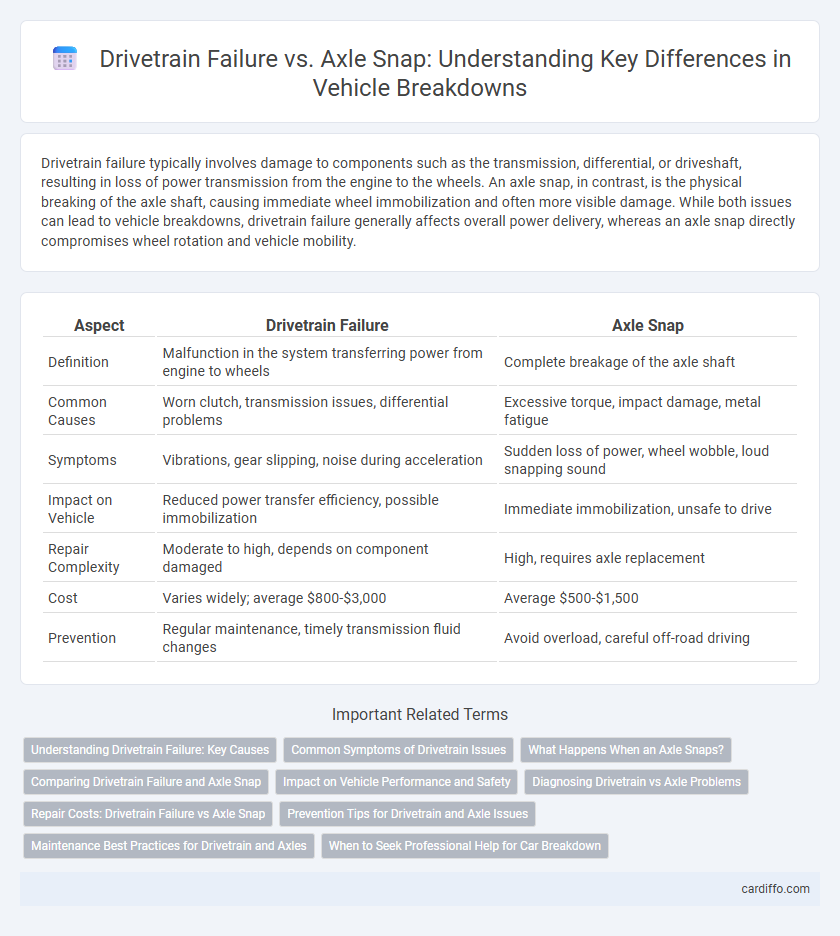Drivetrain failure typically involves damage to components such as the transmission, differential, or driveshaft, resulting in loss of power transmission from the engine to the wheels. An axle snap, in contrast, is the physical breaking of the axle shaft, causing immediate wheel immobilization and often more visible damage. While both issues can lead to vehicle breakdowns, drivetrain failure generally affects overall power delivery, whereas an axle snap directly compromises wheel rotation and vehicle mobility.
Table of Comparison
| Aspect | Drivetrain Failure | Axle Snap |
|---|---|---|
| Definition | Malfunction in the system transferring power from engine to wheels | Complete breakage of the axle shaft |
| Common Causes | Worn clutch, transmission issues, differential problems | Excessive torque, impact damage, metal fatigue |
| Symptoms | Vibrations, gear slipping, noise during acceleration | Sudden loss of power, wheel wobble, loud snapping sound |
| Impact on Vehicle | Reduced power transfer efficiency, possible immobilization | Immediate immobilization, unsafe to drive |
| Repair Complexity | Moderate to high, depends on component damaged | High, requires axle replacement |
| Cost | Varies widely; average $800-$3,000 | Average $500-$1,500 |
| Prevention | Regular maintenance, timely transmission fluid changes | Avoid overload, careful off-road driving |
Understanding Drivetrain Failure: Key Causes
Drivetrain failure primarily results from worn-out components such as the transmission, differential, or driveshaft, which endure constant torque and stress during vehicle operation. Axle snaps, a specific form of drivetrain failure, commonly occur due to metal fatigue, improper maintenance, or excessive load beyond the axle's capacity. Recognizing these key causes enables timely diagnosis and repair, preventing more severe breakdowns and costly replacements.
Common Symptoms of Drivetrain Issues
Common symptoms of drivetrain failure include unusual vibrations, difficulty accelerating, and a noticeable loss of power during driving. In contrast, an axle snap often manifests as a sudden loud noise followed by immediate loss of vehicle movement or uneven tire rotations. Both issues can cause drivetrain warning lights to illuminate, signaling urgent mechanical inspection.
What Happens When an Axle Snaps?
When an axle snaps, the vehicle experiences an immediate loss of power transmission to the wheels, causing sudden and severe handling difficulties. The affected wheel may lock up or detach, leading to potential loss of control and increased risk of accidents. Unlike general drivetrain failure, an axle snap typically results in a loud noise and abrupt vehicle stoppage or veering.
Comparing Drivetrain Failure and Axle Snap
Drivetrain failure typically involves the malfunction of multiple interconnected components such as the transmission, driveshaft, and differential, leading to loss of power transfer from the engine to the wheels. In contrast, axle snap refers specifically to the physical breaking of the axle shaft, resulting in immediate wheel immobilization and severe vehicle handling issues. While drivetrain failure often manifests gradually through symptoms like unusual noises and vibrations, axle snap usually causes sudden breakdowns requiring immediate repair or replacement.
Impact on Vehicle Performance and Safety
Drivetrain failure typically results in a complete loss of power transmission, causing the vehicle to become immobile and potentially leading to hazardous situations on the road. Axle snap, while equally serious, often causes sudden wheel misalignment or detachment, directly affecting vehicle stability and increasing the risk of accidents. Both conditions severely compromise vehicle performance and safety, demanding immediate inspection and repair to prevent further mechanical damage and ensure driver control.
Diagnosing Drivetrain vs Axle Problems
Diagnosing drivetrain failure versus axle snap requires analyzing specific symptoms such as unusual vibrations, clunking noises, and difficulty in vehicle movement. Drivetrain issues often manifest as slipping gears or inconsistent power delivery, while axle snaps typically cause sudden loss of power to the wheels and visible damage. Accurate diagnosis involves inspecting CV joints, U-joints, driveshafts, and axles for wear, cracks, or breaks to pinpoint the exact source of the problem.
Repair Costs: Drivetrain Failure vs Axle Snap
Repair costs for drivetrain failure are typically higher than those for an axle snap due to the complexity and number of components involved, including the transmission, driveshaft, and differential. Axle snap repairs often require axle shaft replacement and potential wheel alignment, resulting in lower labor and parts expenses compared to drivetrain overhauls. Insurance coverage may vary, but drivetrain failures often lead to more extensive claims due to the higher repair costs and potential for associated damage.
Prevention Tips for Drivetrain and Axle Issues
Regularly inspecting drivetrain components such as the transmission, driveshaft, and CV joints helps detect wear and prevent failures. Maintaining proper lubrication levels and promptly replacing damaged seals minimizes friction and overheating that can cause drivetrain breakdowns or axle snaps. Using quality parts and avoiding overloading the vehicle significantly reduces stress on axles and drivetrain systems, extending their operational lifespan.
Maintenance Best Practices for Drivetrain and Axles
Regular inspections of drivetrain components and axle assemblies are essential to prevent failures such as drivetrain malfunction and axle snaps. Applying proper lubrication, torque specifications, and timely replacement of worn parts enhances reliability and reduces the risk of costly breakdowns. Implementing a preventive maintenance schedule based on manufacturer guidelines optimizes drivetrain performance and extends axle lifespan.
When to Seek Professional Help for Car Breakdown
Recognizing the signs of drivetrain failure such as strange noises, loss of power, or difficulty shifting gears is essential to prevent further damage. An axle snap often causes sudden loss of control and unusual vibrations, requiring immediate professional assessment. Seeking expert help promptly ensures accurate diagnosis and safe, efficient repairs, minimizing the risk of costly breakdowns and enhancing vehicle reliability.
Drivetrain failure vs axle snap Infographic

 cardiffo.com
cardiffo.com